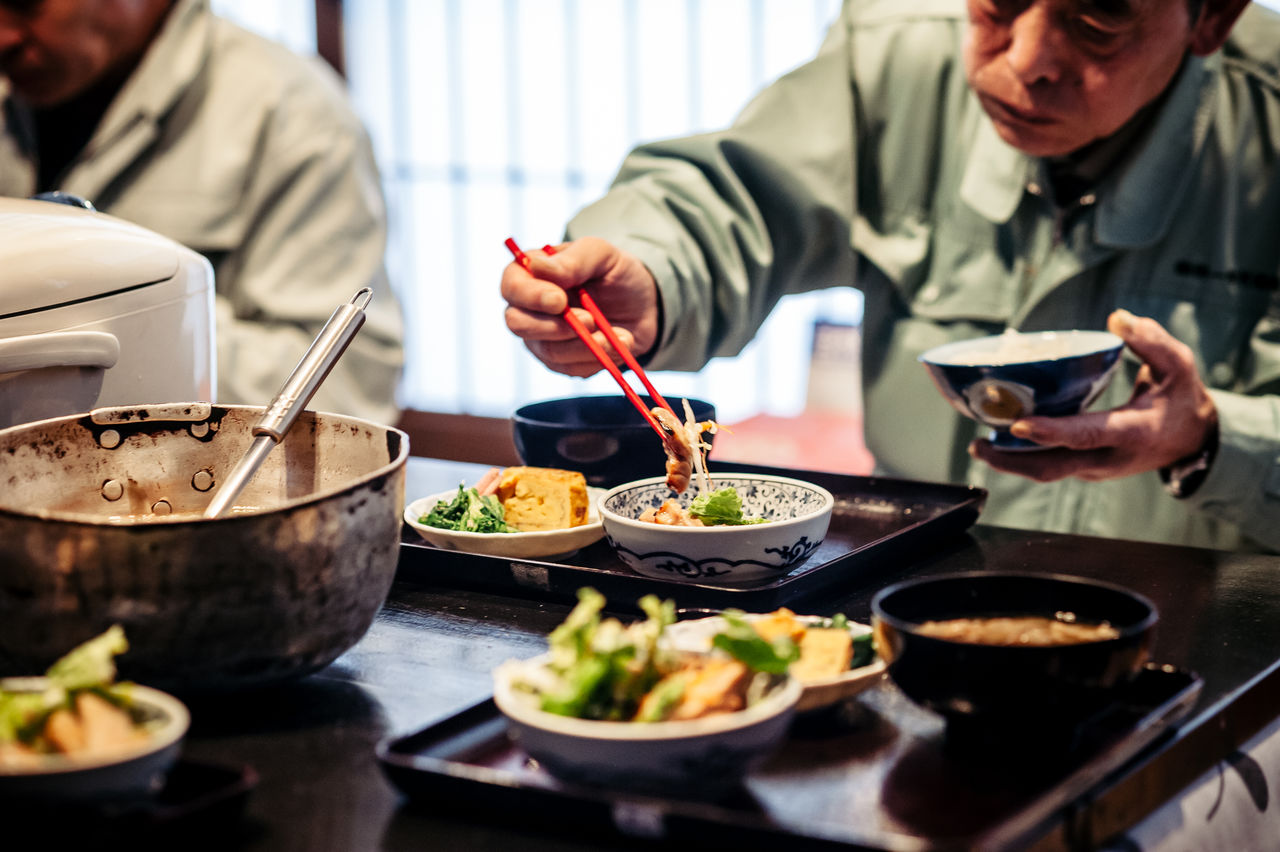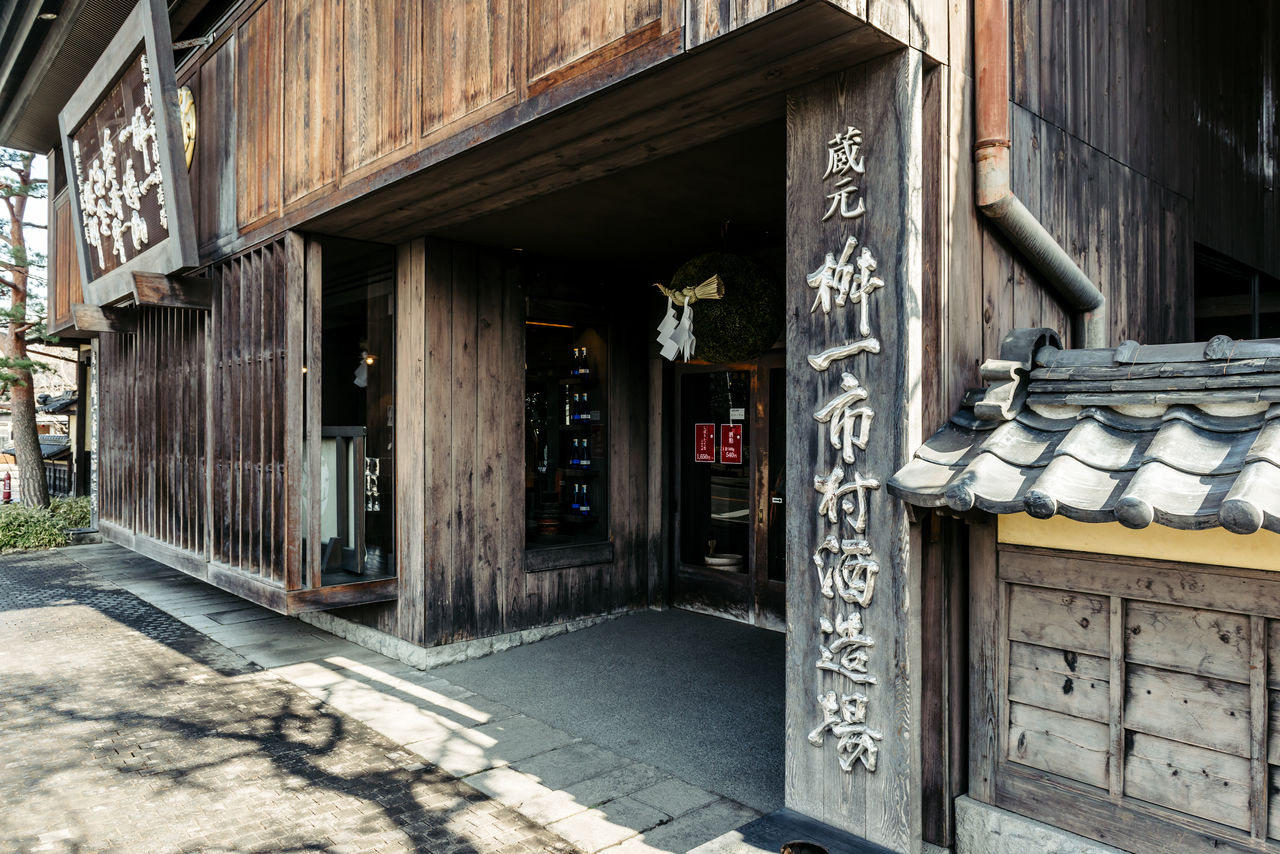
Breakfast Around Japan: A Culinary Adventure
Breakfasting with the Brewers: A Visit to the Masuichi-Ichimura Sake Brewery
Guideto Japan
Food and Drink Lifestyle- English
- 日本語
- 简体字
- 繁體字
- Français
- Español
- العربية
- Русский
Menu
- Raw egg
- Pickles
- Rice
- Miso soup
The small town of Obuse in Nagano Prefecture, set against the scenic backdrop of the famed “five peaks of northern Shinano,” is home to one of Japan’s oldest and most distinguished sake makers: Masuichi-Ichimura Sake Brewery, established in 1755. From November through March (the brewing season), the brewery provides room and board to a skilled crew of artisans known as kurabito, as they apply themselves with single-minded focus to the daily challenges of sake making.
Sake brewing is a complicated and demanding process. The brewing team is a hierarchy, with the tōji, or brewmaster, at the top, assisted by the kashira. Beneath them, ranked in order of prestige, are artisans specializing in the various elements of sake making: The kōjiya is in charge of the kōji mold culture, the motoya is responsible for the yeast starter, the sendō supervises the pressing, the seimaiya handles the rice polishing, and so forth. All these processes must be seamlessly coordinated as the kurabito labor to produce the brewery’s four premium brands, each with its own unique recipe: Hekiiken (junmai daiginjō-shu), Kōzan (junmai daiginjō-shu), Square One (junmai-shu), and Hakkin (wood-barrel-brewed yamahai junmai-shu).
In this context, staff meals play a crucial role, not only in sustaining the kurabito but also in structuring their busy day. In the Masuichi brewers’ lounge, kurabito gather around the kotatsu (a combination table and space heater) to take their nourishment, check their schedules, trade information, and bond as a team.
 The kurabito are up before dawn to begin their long day with a meal together.
The kurabito are up before dawn to begin their long day with a meal together.  The sake-making season in northern Nagano extends from November to March.
The sake-making season in northern Nagano extends from November to March.  It takes years of dedication to master the craft of sake brewing. Masuichi-Ichimura Sake Brewery is one of the few Japanese breweries that takes on women and non-Japanese kurabito eager to learn the trade.
It takes years of dedication to master the craft of sake brewing. Masuichi-Ichimura Sake Brewery is one of the few Japanese breweries that takes on women and non-Japanese kurabito eager to learn the trade.  After a light breakfast, workers partake of heartier lunchtime and dinnertime fare prepared by the staff of the Obusedō Restaurant, located on the grounds of the brewery. Today’s noontime meal features pork sauteed in ginger sauce, tamagoyaki (Japanese rolled omelette), blanched greens in soy sauce, pickles, and piping hot sake-lees soup with pork and vegetables.
After a light breakfast, workers partake of heartier lunchtime and dinnertime fare prepared by the staff of the Obusedō Restaurant, located on the grounds of the brewery. Today’s noontime meal features pork sauteed in ginger sauce, tamagoyaki (Japanese rolled omelette), blanched greens in soy sauce, pickles, and piping hot sake-lees soup with pork and vegetables.  Kurabito approach their meals with the same single-minded focus they apply to their work.
Kurabito approach their meals with the same single-minded focus they apply to their work.  Dinner, not surprisingly, is accompanied by sake. Veteran kurabito Takizawa Zenji pours for tōji Ichikawa Naomichi. Dinnertime ends at 6:00 sharp, at which point the crew begins preparing for the following day’s operations, guided by the elaborate work schedule posted on the wall.
Dinner, not surprisingly, is accompanied by sake. Veteran kurabito Takizawa Zenji pours for tōji Ichikawa Naomichi. Dinnertime ends at 6:00 sharp, at which point the crew begins preparing for the following day’s operations, guided by the elaborate work schedule posted on the wall.
Ichimura Tsugio, the sixteenth hereditary owner of the Masuichi brewery, remembers staff meals going back six decades and more. “Every year on the day before New Year’s, it was the custom for our family to sit down and eat with all the kurabito,” Ichimura recalls. “That’s the way it was up through my junior high school years.” In those days, the owner’s wife was responsible for all the staff meals.
Much has changed since then, both for Masuichi and for the sake industry as a whole. In the 1960s, as large makers reaped the benefits of new mass-production methods and modern machinery, local brewers came under increasing pressure, and many of the smaller ones failed. These pressures intensified as Japanese sake consumption entered into an extended decline around the mid-1970s. Soon, even venerable old establishments like Masuichi were facing an existential crisis. By the 1990s, the choice was clear: either take mass-production to the limit and compete with the big manufacturers, or tap into the growing market for luxury beverages by focusing like a laser on high-end craft sake. Masuichi chose the latter path.
“Each sake that we sell under its own label has to be unique in flavor,” explains Ichimura. “And we use only premium sake rice, even for the kakemai used to make the main mash.” (Kakemai refers to the plain steamed rice that is mixed with rice kōji and yeast starter to make the main mash, or moromi. Some sake brewers use the higher-priced premium sake rice, shuzō-kōtekimai, when preparing their rice kōji but then mix it with a large quantity of ordinary eating rice to make the mash.—Ed.) “This approach to production is hardly what you’d call cost-efficient. But the extra value it imparts to our sake what this brewery is all about.”
 The entrance to Masuichi Honten, the brewery’s sake store
The entrance to Masuichi Honten, the brewery’s sake store  The Japanese-style building was designed by the American architect John Morford.
The Japanese-style building was designed by the American architect John Morford.  The store’s striking interior beckons shoppers and tasters.
The store’s striking interior beckons shoppers and tasters.
Masuichi-Ichimura Sake Brewery is a major driver of tourism in the town of Obuse. Along with a sake store and tasting bar, the brewery site features an upscale inn and several dining options, among other attractions. Visitors can shop for chestnut sweets at Obusedō, an establishment that has operated alongside the brewery since the Meiji era (1868–1912), watch the confections being made, and dine at the Obusedō Restaurant, which makes the brewery workers' staff meals. They can also stroll at their leisure along Kuri no Komichi, a charming pathway paved with chestnut blocks, which takes them through a bamboo garden attached to the stately Ichimura residence.
The Obusedō Restaurant began taking meals to the kurabito a few years ago, after the woman who had prepared the staff meals for many years decided it was time to retire. The private rooms where the workers are lodged during sake-making season were designed by American architect John Morford. Such are the extraordinary job benefits enjoyed by kurabito at the Masuichi brewery.
When it comes to breakfast, however, the workers are on their own; they have a long day ahead of them and need to get started before sunrise. The kurabito themselves prepare the breakfast ingredients in advance the previous night. Up before the rest of the world, they fortify themselves against the dark and cold with a simple but nourishing meal of white rice, miso soup, a raw egg, and pickles. Then it’s back to the tough but gratifying job of brewing some of the best sake in the land.
 A large wooden barrel (oke) of the kind traditionally used for brewing sake holds the place of honor in the entranceway to Masuichi Honten.
A large wooden barrel (oke) of the kind traditionally used for brewing sake holds the place of honor in the entranceway to Masuichi Honten.  Inside the store, shoppers can sample the brewery’s wares at Teppa, the tasting bar.
Inside the store, shoppers can sample the brewery’s wares at Teppa, the tasting bar.  Square One, the brewery’s junmai-shu, is named for the smart Masuichi logo: a square symbolizing a masu (wooden sake vessel) followed by the character for ichi, meaning “one.” The stylish ceramic bottles are an updated version of the refillable sake jars familiar to Japanese antique collectors.
Square One, the brewery’s junmai-shu, is named for the smart Masuichi logo: a square symbolizing a masu (wooden sake vessel) followed by the character for ichi, meaning “one.” The stylish ceramic bottles are an updated version of the refillable sake jars familiar to Japanese antique collectors.
Masuichi-Ichimura Sake Brewery
Address: 807 Obuse, 381-0294, Nagano Prefecture
Phone: +81-(0)26-247-2011
Fax: +81-(0)26-247-6369
Website:http://www.masuichi.com/
E-mail: info@masuichi.com
(Originally published in Japanese. Photos by Inomata Hiroshi. Series title written by Kanazawa Shōko.)
food Washoku sake Breakfast Around Japan: A Culinary Adventure Nagano Obuse breakfast